A Gendered Organizational Analysis of the ... - Campus Activism
A Gendered Organizational Analysis of the ... - Campus Activism
A Gendered Organizational Analysis of the ... - Campus Activism
You also want an ePaper? Increase the reach of your titles
YUMPU automatically turns print PDFs into web optimized ePapers that Google loves.
ano<strong>the</strong>r member. The database was in disarray and had not been updated for at least a year, so rebuilding it was<br />
critical to SEAC’s recovery. Since I was involved with <strong>the</strong> database, I became interested in and knowledgeable<br />
about what groups and members were active in SEAC all across <strong>the</strong> U.S. That summer I attended <strong>the</strong> SEAC<br />
Summer Training Institute and became regional coordinator for Indiana, Illinois, and Michigan after learning that<br />
<strong>the</strong>re was no coordinator and that <strong>the</strong> regional network was in disarray. Since <strong>the</strong>n I have attended two NC<br />
meetings to represent my region. In sum, I was able to become very involved in SEAC, at close to <strong>the</strong> highest<br />
levels, without ever getting elected or being accountable to <strong>the</strong> membership. I believe this is <strong>the</strong> general case, as<br />
most regions are not organized well enough to hold elections, and SEAC lacked for volunteer support ever since<br />
<strong>the</strong> 1996 crisis.<br />
I believe that class is key to my becoming so involved, but gender played an indirect and less obvious<br />
role. I became a SEAC ‘leader’ because I was able to volunteer a lot <strong>of</strong> time without pay, and fund my own<br />
travel and registration costs. However class should not be a factor in <strong>the</strong> observed gender disparity in leadership<br />
since men and women are likely to be equally supported by <strong>the</strong>ir parents. Thus what matters most is whe<strong>the</strong>r <strong>the</strong><br />
individual man or woman is willing to take <strong>the</strong> step and volunteer for leadership. This decision is influenced by<br />
general society that encourages men to be leaders and women to be followers. More obviously than <strong>the</strong> subtle<br />
external influence <strong>of</strong> social conditioning, I was able to assist SEAC by creating a complex relational database<br />
because I studied computer science, a field that was roughly 80% male. Also my original contact with SEAC was<br />
over <strong>the</strong> Internet (and thus gendered male), and only occurred because I was subscribed to a large number <strong>of</strong><br />
email lists.<br />
Acker’s Second <strong>Gendered</strong> Process: Explicit and Implicit Ideology<br />
Acker’s next gendered process involves “...<strong>the</strong> creation <strong>of</strong> symbols, images, and forms <strong>of</strong> consciousness that<br />
explicate, justify, and, more rarely, oppose gender divisions” (1992, 253). These include “language, ideology . . .<br />
[and] dress” (1990, 146). SEAC is one <strong>of</strong> those rare cases where in most cases this gendered process is used to<br />
oppose gender divisions in specific and sexism in general.<br />
SEAC is a student run and student led national network <strong>of</strong> progressive organizations and<br />
individuals whose aim is to uproot environmental injustices through action and education. We<br />
define <strong>the</strong> environment to include <strong>the</strong> physical, economical, political and cultural conditions in<br />
which we live. By challenging <strong>the</strong> power structure that threatens <strong>the</strong>se environmental<br />
14



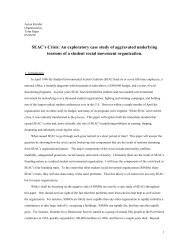
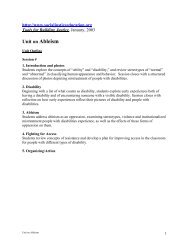

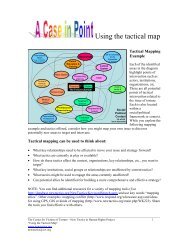
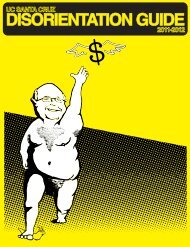

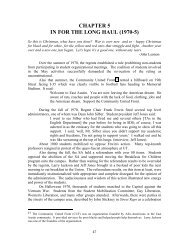
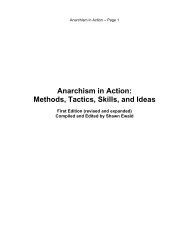



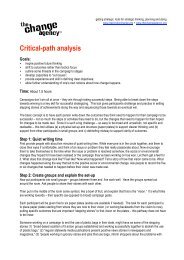

![Meaningful Student Involvement Research Guide [pdf] - SoundOut](https://img.yumpu.com/38822556/1/190x231/meaningful-student-involvement-research-guide-pdf-soundout.jpg?quality=85)